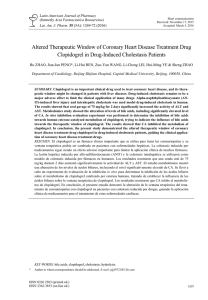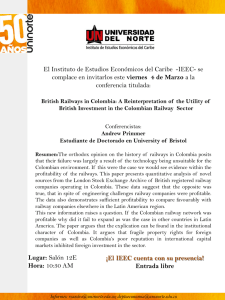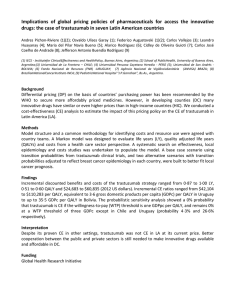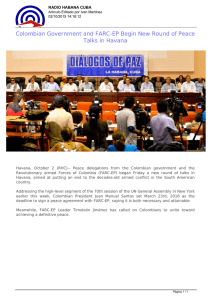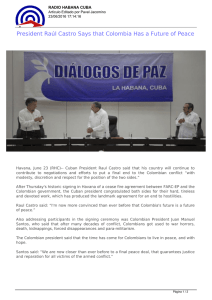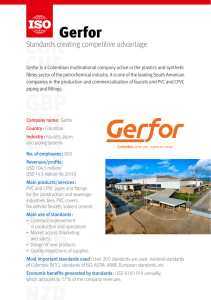Cost-effectiveness analysis of ticagrelor compared to clopidogrel for
Anuncio
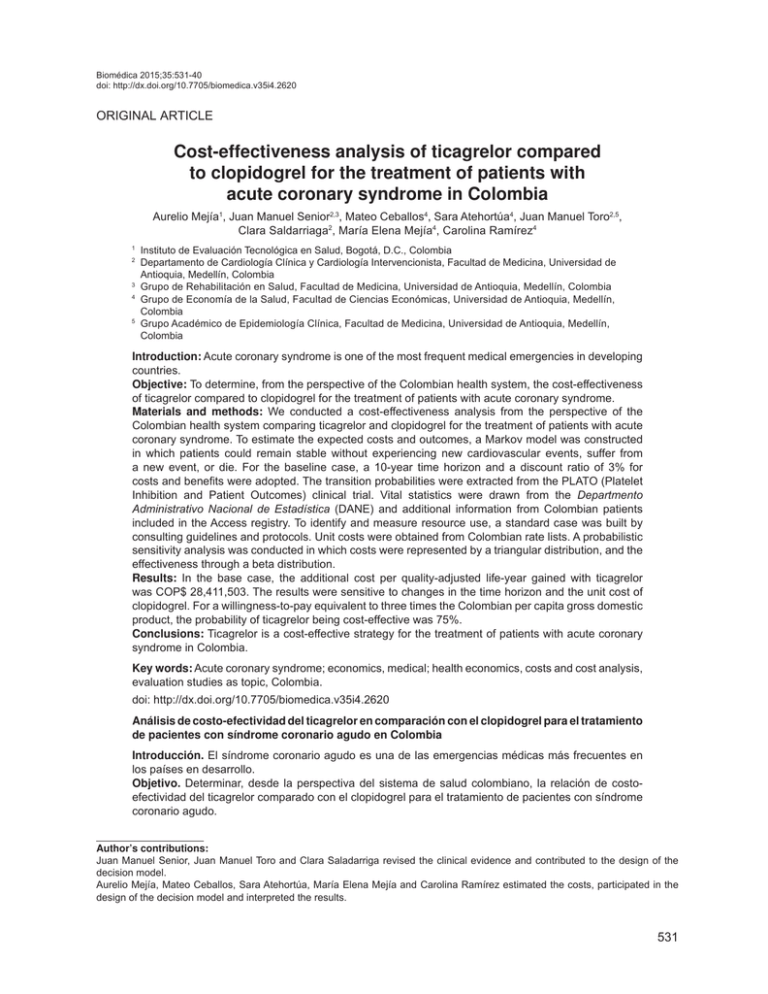
Biomédica 2015;35:531-40 doi: http://dx.doi.org/10.7705/biomedica.v35i4.2620 Cost-effectiveness of ticagrelor for acute coronary syndrome ORIGINAL ARTICLE Cost-effectiveness analysis of ticagrelor compared to clopidogrel for the treatment of patients with acute coronary syndrome in Colombia Aurelio Mejía1, Juan Manuel Senior2,3, Mateo Ceballos4, Sara Atehortúa4, Juan Manuel Toro2,5, Clara Saldarriaga2, María Elena Mejía4, Carolina Ramírez4 1 2 Instituto de Evaluación Tecnológica en Salud, Bogotá, D.C., Colombia Departamento de Cardiología Clínica y Cardiología Intervencionista, Facultad de Medicina, Universidad de Antioquia, Medellín, Colombia 3 Grupo de Rehabilitación en Salud, Facultad de Medicina, Universidad de Antioquia, Medellín, Colombia 4 Grupo de Economía de la Salud, Facultad de Ciencias Económicas, Universidad de Antioquia, Medellín, Colombia 5 Grupo Académico de Epidemiología Clínica, Facultad de Medicina, Universidad de Antioquia, Medellín, Colombia Introduction: Acute coronary syndrome is one of the most frequent medical emergencies in developing countries. Objective: To determine, from the perspective of the Colombian health system, the cost-effectiveness of ticagrelor compared to clopidogrel for the treatment of patients with acute coronary syndrome. Materials and methods: We conducted a cost-effectiveness analysis from the perspective of the Colombian health system comparing ticagrelor and clopidogrel for the treatment of patients with acute coronary syndrome. To estimate the expected costs and outcomes, a Markov model was constructed in which patients could remain stable without experiencing new cardiovascular events, suffer from a new event, or die. For the baseline case, a 10-year time horizon and a discount ratio of 3% for costs and benefits were adopted. The transition probabilities were extracted from the PLATO (Platelet Inhibition and Patient Outcomes) clinical trial. Vital statistics were drawn from the Departmento Administrativo Nacional de Estadística (DANE) and additional information from Colombian patients included in the Access registry. To identify and measure resource use, a standard case was built by consulting guidelines and protocols. Unit costs were obtained from Colombian rate lists. A probabilistic sensitivity analysis was conducted in which costs were represented by a triangular distribution, and the effectiveness through a beta distribution. Results: In the base case, the additional cost per quality-adjusted life-year gained with ticagrelor was COP$ 28,411,503. The results were sensitive to changes in the time horizon and the unit cost of clopidogrel. For a willingness-to-pay equivalent to three times the Colombian per capita gross domestic product, the probability of ticagrelor being cost-effective was 75%. Conclusions: Ticagrelor is a cost-effective strategy for the treatment of patients with acute coronary syndrome in Colombia. Key words: Acute coronary syndrome; economics, medical; health economics, costs and cost analysis, evaluation studies as topic, Colombia. doi: http://dx.doi.org/10.7705/biomedica.v35i4.2620 Análisis de costo-efectividad del ticagrelor en comparación con el clopidogrel para el tratamiento de pacientes con síndrome coronario agudo en Colombia Introducción. El síndrome coronario agudo es una de las emergencias médicas más frecuentes en los países en desarrollo. Objetivo. Determinar, desde la perspectiva del sistema de salud colombiano, la relación de costoefectividad del ticagrelor comparado con el clopidogrel para el tratamiento de pacientes con síndrome coronario agudo. Author’s contributions: Juan Manuel Senior, Juan Manuel Toro and Clara Saladarriga revised the clinical evidence and contributed to the design of the decision model. Aurelio Mejía, Mateo Ceballos, Sara Atehortúa, María Elena Mejía and Carolina Ramírez estimated the costs, participated in the design of the decision model and interpreted the results. 531 Mejía A, Senior JM, Ceballos M, et al. Biomédica 2015;35:531-40 Materiales y métodos. Se hizo un análisis de costo-efectividad desde la perspectiva del sistema de salud colombiano, comparando el ticagrelor y el clopidogrel para el tratamiento de pacientes con síndrome coronario agudo. Para estimar los costos y resultados esperados de las dos alternativas, se construyó un modelo de Markov en el cual los pacientes podían permanecer estables sin experimentar nuevos eventos cardiovasculares, sufrir de un nuevo evento coronario o morir. Para el caso de base, se adoptó un horizonte temporal de 10 años y una tasa de descuento de 3 % para los costos y beneficios. Las probabilidades de transición se extrajeron del estudio Platelet Inhibition and Patient Outcomes, PLATO. Las estadísticas vitales se consultaron en informes del Departamento Administrativo Nacional de Estadística (DANE) y los parámetros adicionales del modelo se basaron en la información de los pacientes colombianos incluidos en el registro en Access. Para identificar y medir el uso de recursos, se construyó un caso estándar a partir de guías y protocolos. Los costos unitarios se obtuvieron de manuales tarifarios colombianos. Se hizo un análisis de sensibilidad probabilístico en el que los costos se representaron por una distribución triangular y, las probabilidades de transición, mediante una distribución beta. Resultados. En el caso de base, el costo adicional por años de vida ajustados por calidad ganados con el ticagrelor fue de COP$ 28’411.503. Los resultados fueron sensibles a los cambios en el horizonte temporal y al costo unitario del clopidogrel. Para un umbral de costo-efectividad equivalente a tres veces el producto interno bruto per cápita de Colombia, la probabilidad de que el ticagrelor fuera costoefectivo fue de 75 %. Conclusiones. El ticagrelor es una estrategia costo-efectiva para el tratamiento de los pacientes con síndrome coronario agudo en Colombia. Palabras clave: síndrome coronario agudo, economía médica, economía de la salud, costos y análisis de costo, estudios de evaluación como tema, Colombia. doi: http://dx.doi.org/10.7705/biomedica.v35i4.2620 The acute coronary syndrome is one of the most frequent medical emergencies in developing countries and one of the most prevalent manifestations of cardiovascular disease (1). In Colombia, according to the vital statistics 2007-2008 issued by the Departamento Administraivo Nacional de Estadística (DANE) (2), the rate of mortality from ischemic heart disease during this time period among 45-year old and older adults was 263.7/100,000. Life expectancy in the Colombian population is projected to increase from 67.8 years during 1985-1990 period to 73.9 years in 2010-2015. Thus, during this time the population older than 45 will triple leading to an increase in the incidence and prevalence of atherosclerotic cardiac disease and, by consequence, an increase in the cost of health care. According to statistics published by DANE, and based on the international disease classification CIE-10, ischemic cardiac disease was the leading cause of death in persons 55 and older, surpassing cancer and violence. The high morbidity and mortality of this illness pose Corresponding author: Sara Atehortúa, Grupo de Economía de la Salud, Facultad de Ciencias Económicas, Universidad de Antioquia, Calle 67 N° 53-108, oficina 13-404, Medellín, Colombia Telephone: (574) 219 5816 [email protected] Recibido: 21/11/14; aceptado: 09/06/15 532 an important challenge given its impact on health status, quality of life, and on social, labour and economic indicators. The acute coronary syndrome has high social costs due to the treatment and the loss of productivity among those who experience an event. Multiple studies have been conducted to determine the most cost-effective treatment and its optimal duration, and have found that individuals who receive standard treatment with aspirin after an acute coronary event remain at high risk of experiencing coronary events in the short and long term (3-6). Therefore, medications such as clopidogrel have been developed that, when added to conventional treatment with aspirin, improve the patient’s quality of life and reduce the risk of new cardiovascular events (7,8). Recently, new medications have been introduced for dual therapy use, such as ticagrelor (9), which has demonstrated increased effectiveness as compared with aspirin plus clopidogrel, but with high costs. The high effectiveness but high cost of ticagrelor poses a dilemma regarding which alternative should be implemented in the Colombian health system to achieve the highest benefits to health while taking into account the budgetary restrictions in the country. Therefore, the objective of this article was to evaluate, from the perspective of the Colombian health system, the cost-effectiveness of Biomédica 2015;35:531-40 Cost-effectiveness of ticagrelor for acute coronary syndrome aspirin plus ticagrelor treatment compared to aspirin plus clopidogrel for patients with acute coronary syndrome in Colombia. This study was performed during the development of the Colombian guideline for patients with acute coronary syndrome (1), and it was an input that the guideline development group took into consideration when they were generating recommendations about optimal medical treatment for patients with acute coronary syndrome. Materials and methods We developed a cost-effectiveness analysis from the perspective of the Colombian health system (i.e., only direct medical costs and health benefits perceived by patients were considered). The population consisted of 18-year old or older patients with acute coronary syndrome, with or without ST segment elevation (9). The alternatives evaluated were: 1. Aspirin plus clopidogrel, which is the contemplated in the current protocol Colombian health system, with an initial clopidogrel of 300 mg, and then 75 mg for a year. strategy of the dose of per day 2. Aspirin plus ticagrelor (new treatment), with an initial dose of ticagrelor of 180 mg, and then 90 mg twice a day for a year. From here on, clopidogrel or ticagrelor treatment should be understood to mean dual antiplatelet therapy. We included these alternatives because they were those evaluated by the guideline development group to be incorporated in the clinical guideline for adults with acute coronary syndrome (1). Another antiplatelet available (prasugrel) is not considered in the analysis given the absence of head-to-head trial data (and even credible indirect evidence) comparing ticagrelor to prasugrel at the time this analysis was performed. The natural history of the disease goes through different stages including acute events such as myocardial infarction, stroke, and death, as well as non-fatal health outcomes (1). We considered, therefore, that a Markov model could be useful to represent the natural history of the acute coronary syndrome and estimate the expected cost and effectiveness of both interventions. During the first year, four possible outcomes were considered: myocardial infarction, stroke, no event, and death. Patients who experienced a myocardial infarction or stroke could die or progress to the postmyocardial infarction or post-stroke stage. These two last stages enabled us to capture the costs and outcomes of the patients who experienced a non-fatal event during the first year of follow-up or in one of the following years. The model is depicted in figure 1. In the base case analysis, patients who experience either a myocardial infarction or stroke progress to postmyocardial infarction, post-stroke, or death. However, it is possible that a patient who experiences a myocardial infarction or stroke during the first year will experience a new event in following years. Therefore, to take this possibility into account, we performed a sensitivity analysis in which the structure of the model was modified to include the probability of experiencing new coronary events in the long term. The “no event” stage captured the patients who did not experience a new event. The simulation was set up such that the patients that remained in this stage were at risk of experiencing new events. Taking published models into account and the fact that relevant clinical trials had a <1-year follow up, we assumed that no differences existed between the risks of any of these events after the first year. This meant that the effect of the long-term strategies was fundamentally determined by the effects the strategies had on the outcomes in the first year. To estimate the effectiveness of ticagrelor, a systematic review was conducted by searching Medline (PubMed) (see search strategy in table 1). The search did not yield any systematic reviews, and only one clinical trial was found that compared ticagrelor to clopidogrel for treatment of acute coronary syndrome patients (9). This article was considered of high quality according to the guideline development group (1). From that study we estimated the probabilities of the different events in the model during the first year. The probability of death (adjusted for age) was based on vital statistics from DANE. The risk of new coronary events in the long term was estimated using the information from Colombian patients included in the Access registry. The main outcome of this analysis was the qualityadjusted life-year (QALY). Utility weights for each outcome were derived from the PLATO HECON study (10) (the data used correspond to the general average of all countries; although Colombian patients participated in this study, no disaggregated data by country were available) (table 2). Given that death is not the only event of interest and quality 533 Mejía A, Senior JM, Ceballos M, et al. Biomédica 2015;35:531-40 No event MI No event Stroke Death Post-MI MI Death Post-stroke Stroke Clopidogrel Death M Post-MI Post-MI Death ACS patients Post-stroke Post-stroke Death Death Ticagrelor M + Figure 1. Decision model for the comparison between ticagrelor and clopidogrel Table 1. Medline search strategy using PubMed (Date of search: February, 2012) (Acute Coronary Syndrome[Mesh] OR Acute Coronar*[tiab] OR Coronary Syndrom*[tiab] OR STEMI[tiab] OR non-STEMI[tiab]) AND (systematic review[tiab] OR Meta-Analysis[pt] OR Meta-Analysis as Topic[mh] OR Meta-Analys*[tiab] OR “Cochrane Database Syst Rev”[Journal:__jrid21711]) AND (Aspirin[Mesh] OR Acetylsalicylic Acid[tiab] OR aspirin*[tiab] OR ASA[tiab]) AND (clopidogrel[all] OR ticagrelor [all]) of life after non-fatal events is a critical outcome, the QALY is an appropriate outcome for the analysis as it allows combining the effect of the interventions on both the length and quality of life. To estimate the cost of each health outcome we identified the resources with the highest expected impact on total costs and therefore the highest probability of influencing the decision, such as hospitalization in the intensive care unit, the type of stent (drug-eluting or bare metal stent) for the percutaneous coronary intervention, cardiac rehabilitation programs, and medications, among others. Resource use was quantified by constructing a standard case based on the review of clinical practice guidelines and hospital protocols from a Colombian teaching hospital in Medellín. These results were discussed with various internal medicine and cardiology experts, and through informal consensus the frequency for each item 534 was estimated. Details of the resources included, unit of measurement and frequency can be found in the clinical practice guideline (1). The unit cost of medication (table 3) was obtained from the Colombian system of information of medication prices (SISMED) (11). The unit cost corresponds to the weighted price (according to number of units sold) for the different presentations in the Colombian market, including generic as well as brand name version of the medications. To estimate unit cost of medical and surgical procedures, a survey was administered to various Colombian health insurance companies to identify the fees manuals most used to hire providers. From this consultation, we determined that the different manuals could be equated to the values reported in the 2001 fees manual of the former Instituto de Seguro Social (ISS) plus 30%, with a minimum percentage of 25% and a maximum of 48%. Finally, Biomédica 2015;35:531-40 Cost-effectiveness of ticagrelor for acute coronary syndrome Table 2. Effectiveness information utilized in models Variable Transition probabilities Probability of myocardial infarction, year 1, ticagrelor Probability of stroke, year 1, ticagrelor Probability of death, year 1, ticagrelor Probability of myocardial infarction, year 1, clopidogrel Probability of stroke, year 1, clopidogrel Probability of death, year 1, clopidogrel Probability of myocardial infarction, long term Probability of stroke, long term Utility weights No event Value Distribution parameters 0.0540 0.0134 0.0378 0.0638 0.0114 0.0476 0.031 0.015 n=504; N=9333 n=125; N=9333 n=353; N=9333 n=593; N=9291 n=106; N=9291 n=442; N=9291 NA NA Wallentin, et al. (9) 0.842 α=28004,078; β=5254,922 α=1341,11861; β=5254,922 α=1467,80073; β=620,10927 α=83,55494391; β=18,21721676 α=101,64825; β=42,94385526 Astra Zeneca (10) NA NA NA NA Astra Zeneca (10) Myocardial infarction 0.779 Stroke 0.703 Post-myocardial infarction stage 0.821 Post-stroke stage 0.703 RR to adjust mortality RR mortality after myocardial infarction, year 1 RR mortality after myocardial infarction, long term RR mortality after stroke, year 1 RR mortality after stroke, long term 5.84 2.21 7.43 2.07 Source Colombian patient data from Access registry RR: Relative risk Table 3. Medication price per unit Antiplatelets Unit Unit costs (COP) Total annual cost Clopidogrel Ticagrelor Clopidogrel (maximum price according to the Ministry of Health Resolution 4316 from 2011) mg mg mg $ 34.38 $ 37.86 $ 71.83 $ 948,796 $ 2,487,475 $ 1,982,508 Source: SISMED and AstraZeneca (for ticagrelor) for medical supplies, information provided by a level 3 hospital in the city of Medellín was used. All prices are given in 2010 Colombian pesos, as they represent the opportunity costs of the interventions at the time of the study. In the baseline case, a time horizon of 10 years was assumed, although results from years 1 and 5 are also presented. A discounted rate of 3% was used for costs and effectiveness alike according to the recommendations from the Colombian methodology guide (12). A long-term time horizon is appropriate considering that health outcomes and costs do not occur only during the first year and it is important to include the effect of long-term outcomes in the estimation of expected costs and effects of the interventions evaluated. The estimation of mean costs and QALYs for each alternative can lead to four possible scenarios (13): a) The intervention (ticagrelor) costs more than the control (clopidogrel) and produces less QALYs. In this case, we say that the intervention is ‘dominated’ by the control. b) Conversely, the intervention costs less than the control and produces more QALYs, that is, the intervention ‘dominates’ the control. c) The intervention costs more and generates more QALYs than the control, and d) The intervention costs less and generates fewer QALYs than the control. If neither the intervention nor comparator treatments are dominated (scenarios A and B), the incremental cost effectiveness ratio (ICER) can be calculated as the ratio of differential mean cost to differential mean QALYs, that is, ICER= Mean Cost Intervention - Mean Cost Control Mean QALYs Intervention - Mean QALYs Control 535 Mejía A, Senior JM, Ceballos M, et al. Biomédica 2015;35:531-40 Comparing the incremental costs and effectiveness of an intervention generates an estimated cost per QALY. Assuming that we have a decision maker with legitimacy and an exogenously defined budget constraint, then the decision maker can compare the cost-effectiveness of the intervention with the threshold cost per QALY (14). In Colombia, such threshold has not been explicitly defined, and the aim of this evaluation is not to develop an estimate of willingness to pay for health results. However, to interpret the results of this study, we resorted to the recommendation by the World Health Organization that an intervention can be considered cost-effective if the incremental costeffectiveness ratio is less than three times the percapita gross domestic product, which corresponded to COP$ 36,143,349 in 2010. Both probabilistic and deterministic sensibility analyses were conducted to determine the impact of uncertainty on the results. With regard to the price of clopidogrel, a deterministic sensitivity analysis was conducted using the maximum reimbursement price stipulated by the Colombian government (Resolution 4316 from 2011). We also performed a sensitivity analysis for the discount rate (0% and 5%). For the probabilistic analysis, the cost for each of the outcomes was represented by a triangular distribution, which is a continuous distribution function used in situations where not very much information is available regarding the distribution of variables. Specifically, it is necessary to define three values: the minimum expected value, the mode, and the maximum expected value. To estimate each of these values, we considered the different percentages for contracting health services mentioned above (table 4). Following standard practice, we used a beta distribution to represent transition probabilities and utility weights. This distribution generates values between 0 and 1 and, therefore, it is adequate to represent probabilities and utility weights (particularly in this case, where we did not have health states that generate negative utility weights). Results of probabilistic sensitivity analysis are shown as cost-effectiveness acceptability curves (CEAC). The CEAC is derived from the joint density of incremental costs and incremental effects and shows the probability that any strategy is cost effective given the data, i.e., it has the highest net benefit, for different values of the threshold. All calculations were conducted using TreeAge Pro 2009® software. As we did not make any kind of intervention or modification in the biological, physiological or social variables of the individuals under analysis, this research was considered a project with no risk according to Resolution 8430 of the Ministerio de Salud (15), and, therefore, no informed consent or approval by an ethics committee on human research was required. Results In the base case and with a time horizon of 10 years, using ticagrelor involved an additional cost of COP$ 2,033,825 and an increase of 0.072 QALYs, thus generating an ICER of COP$ 28,411,503, which means that the treatment with ticagrelor would be a cost-effective strategy for the Colombian health system. The results are sensitive to changes in the time horizon and in the unit cost of clopidogrel (table 5). With regards to the time horizon, the cost per QALY gained was COP$ 244,567,477 considering only the cost and effectiveness of the first year. This value decreased to COP$ 20,756,184 per QALY gained when the time horizon was 20 years. Regarding the price of clopidogrel, the cost per QALY gained decreased to COP$ 11,321,457 when we used the maximum regulated price of clopidogrel and assumed a time horizon of 10 years. Results of probabilistic sensitivity analysis are shown in figure 2 where it is clear that ticagrelor is generally associated with higher costs, but the Table 4. Costs of outcomes considered in the model Outcome Myocardial infarction Cost of cardiac rehabilitation program Stroke Post-stroke ISS: Instituto de Seguro Social 536 Minimum (ISS fees + 25%, conventional stent) Mode (ISS fees + 30%, conventional stent) Maximum (ISS fees + 48%, medicated stent) $ 8,431,277 $ 815,906 $ 2,143,076 $ 335,076 $ 8,579,284 $ 848,543 $ 2,219,670 $ 346,221 $ 12,878,934 $ 966,033 $ 2,495,412 $ 386,343 Biomédica 2015;35:531-40 Cost-effectiveness of ticagrelor for acute coronary syndrome Table 5. Deterministic sensibility analysis: Time horizon, price of clopidogrel, and discount ratio Strategy Time horizon 1 year Clopidogrel Ticagrelor 5 years Clopidogrel Ticagrelor 10 years Clopidogrel Ticagrelor Price of clopidogrel $948.796 Clopidogrel Ticagrelor $1.982.508 Clopidogrel Ticagrelor Discount ratio 0% Clopidogrel Ticagrelor 5% Clopidogrel Ticagrelor Cost per patient Incremental cost Effectiveness Incremental effectiveness C/E Incremental C/E ratio $ 1,670,802 $ 3,108,240 $ 1,437,438 0.798 QALY 0.804 QALY 0.006 QALY $ 2,094,575 $ 3,868.095 $ 244,567,477 $ 3,132,499 $ 4,924,248 $ 1,791,749 4.330 QALY 4.372 QALY 0.042 QALY $ 723,397 $ 1,126,233 $ 42,605,827 $ 4,068,434 $ 6,102,258 $ 2,033,825 7.162 QALY 7.233 QALY 0.072 QALY $ $ 568,083 843,638 $ 28,411,503 $ 4,068,434 $ 6,102,258 $ 2,033,825 7.162 QALY 7.233 QALY 0.072 QALY $ $ 568,083 843,638 $ 28,411,503 $ 5,291,817 $ 6,102,258 $ 810,441 7.162 QALY 7.233 QALY 0.072 QALY $ $ 738,907 843,638 $ 11,321,457 $ 4,441,479 $ 6,527,591 $ 2,086,112 8.231 QALY 8.314 QALY 0.083 QALY $ $ 539,574 785,112 $ 25,206,909 $ 3,861,266 $ 5,866,053 $ 2,004,787 6.572 QALY 6.637 QALY 0.065 QALY $ $ 587,548 883,807 $ 30,644,159 C/E: Cost effectiveness QALY: Quality-adjusted life-year 1,0 $6,6M 0,9 $6,1M Cost $5,6M $5,1M $4,6M $4,1M $3,6M 6,850 QALY 7,050 QALY 7,250 QALY 7,450 QALY Effectiveness Clopidogrel Ticagrelor Figure 2. Simulation results difference in effectiveness is subject to a greater uncertainty. However, for a threshold equivalent to three times the Colombian per-capita gross domestic product, the probability of ticagrelor being a cost-effective strategy was close to 75% and approached 1 as the threshold neared 80 million (figure 3). Probability that the intervention is cost-effective $7,1M 0,8 0,7 0,6 0,5 0,4 0,3 0,2 0,1 0,0 $0M $22M $44M $66M $88M Threshold Clopidogrel Ticagrelor Figure 3. Acceptability curve for the comparison between ticagrelor and clopidogrel The conclusions were similar in the model that considered the probability of new cardiovascular events in the long term (table 6). 537 Mejía A, Senior JM, Ceballos M, et al. Biomédica 2015;35:531-40 Table 6. Ticagrelor vs. clopidogrel: Results at 5 and 10 years considering the probability of reinfarction Time horizon 5 years 10 years Strategy Cost per patient Clopidogrel Ticagrelor Clopidogrel Ticagrelor $ 3,194,821 $ 4,840,904 $ 4,162,110 $ 5,943,761 Incremental cost $ 1,646.083 $ 1,781,650 Effectiveness 4.329 QALY 4.372 QALY 7.159 QALY 7.232 QALY Incremental effectiveness 0.043 QALY 0.073 QALY C/E $ 738,073 $ 1,107,347 $ 581,370 $ 821,903 Incremental C/E ratio $ 38,258,072 $ 24,551,985 C/E: Cost effectiveness QALY: Quality-adjusted life-year Discussion The results of this economic analysis suggest that ticagrelor is a cost-effective strategy in Colombia and that it could be included in the health benefits plan of the country’s health system. This conclusion is consistent across different scenarios and sensitivity analyses, although two variables may modify the results: The time horizon, and the annual cost of treatment with clopidogrel considered as appropriate by the decision-maker. With regard to the time horizon, short-term results can underestimate the actual costs and benefits of the alternatives and can therefore lead to wrong decisions. Keeping this in mind, this study adopted a time horizon that was large enough to capture the effects of the technologies and long-term costs that can be more relevant to decision-makers. This analysis tried to incorporate the best available evidence regarding the effectiveness of ticagrelor for the treatment of the acute coronary syndrome. The results from the most important clinical trial comparing both medications were considered, as were results from Colombian studies. Using a Markov model, we estimated the expected longterm impact of the interventions with the aim of including all the costs and consequences implied by the interventions that may be relevant to decisionmaking. The results of this cost-effectiveness analysis are applicable to Colombia, but could be useful to other countries if the costs and utility weights are adjusted according to the clinical practice in a particular setting. Our conclusions coincide with those of several economic evaluations comparing ticagrelor and clopidogrel for acute coronary syndrome treatment (10,16-18). The studies suggest that, although ticagrelor was associated with higher costs, the reductions in mortality and morbidity result in its ICER falling below conventional threshold values, including those recommended by the World Health Organization. Moreover, some studies suggest 538 that ticagrelor could be a dominant alternative over clopidogrel, as it offers more benefits to patients at a lower cost (19,20). Our study has several limitations. First, the effectiveness data, in particular the transition probabilities, were taken from information available in published articles; however, Colombian patients were included in the studies and we can expect similar results for the Colombian population. Considering that the difference in effectiveness between the two alternatives is subject to considerable uncertainty, studies on ticagrelor performance in Colombian patients would be valuable to reduce such uncertainty. Second, the utility weights for each health outcome were based on the UK valuation of the EQ-5D, but we do not feel this is inappropriate considering that we do not have valuations in Colombia for any instrument to measure health-related quality of life. To acknowledge this uncertainty, the utility weights were represented by probability distributions. In conclusion, the results of this study suggest that ticagrelor is a cost-effective strategy for the treatment of patients with acute coronary syndrome in Colombia. Data on its performance in Colombian patients would be very valuable to reduce uncertainty and thus provide more accurate information to decisionmakers. Acknowledgements This article was written as part of the development of the clinical guideline for early detection, treatment, follow-up, and rehabilitation of patients diagnosed with an acute coronary episode, which was led by the Universidad de Antioquia in association with the Universidad Nacional and the Pontificia Universidad Javeriana in Bogotá. The guideline development group consisted of Juan Manuel Senior, Luz Helena Lugo, Oscar Ossio, James Díaz, Juan Manuel Toro, Clara Saldarriaga, Jorge Luis Acosta, Jesús Alberto Plata, Aurelio Mejía, Sara Biomédica 2015;35:531-40 Cost-effectiveness of ticagrelor for acute coronary syndrome Atehortúa, Mateo Ceballos, María Elena Mejía, Carolina Ramírez, Erick Trespalacios, Álvaro Quintero, Pilar Pastor, Manuel Urina, Ricardo Bohórquez, Sebastián Vélez, Eduardo Ramírez, Fernán del Cristo Mendoza, Juan José Vélez, Paula Andrea Castro, Paola Andrea Ramírez, and Ángela Orozco. We thank two anonymous referees for their comments on a previous draft. Any error or omission is the sole responsibility of the authors. Conflicts of interest Juan Manuel Senior was president of the Asociación Colombiana de Medicina Interna and participated in the execution of the international, multicentric Trilogy ACS study. At the time of the study, Aurelio Mejía was lecturer and researcher at the Facultad de Medicina, Universidad de Antioquia. Financing Departamento Administrativo de Ciencia, Tecnología e Innovación (Colciencias) and Ministerio de Salud y Protección Social - Estrategia de Sostenibilidad, 2013-2014, Grupo de Rehabilitación en Salud, Facultad de Medicina, Universidad de Antioquia. References 1. Ministerio de Salud y Protección Social, Colciencias, Universidad de Antioquia. Guía de práctica clínica para el síndrome coronario agudo. Bogotá; 2013. Fecha de consulta: 7 de junio de 2012. Disponible en: http://gpc. minsalud.gov.co/Documents/Guias-PDF-Recursos/SCA/ GPC_Comple_SCA.pdf. 2. Departamento Administrativo Nacional de Estadística. Estadísticas vitales. Fecha de consulta: 7 de junio de 2012. Disponible en: http://www.dane.gov.co/index.php/poblaciony-registros-vitales/nacimientos-y-defunciones/nacimientosy-defunciones. 3. Karnon J, Bakhai A, Brennan A, Pandor A, Flather M, Warren E, et al. A cost-utility analysis of clopidogrel in patients with non-ST-segment-elevation acute coronary syndromes in the UK. Int J Cardiol. 2006;109:307-16. http:// dx.doi.org/10.1016/j.ijcard.2005.06.026 4. Main C, Palmer S, Griffin S, Jones L, Orton V, Sculpher M, et al. Clopidogrel used in combination with aspirin compared with aspirin alone in the treatment of non-STsegment-elevation acute coronary syndromes: A systematic review and economic evaluation. Health Technol Assess. 2004;8:1-141. http://dx.doi.org/10.3310/hta8400 5. Berg J, Lindgren P, Spiesser J, Parry D, Jönsson B. Cost-effectiveness of clopidogrel in myocardial infarction with ST-segment elevation: A European model based on the CLARITY and COMMIT trials. Clin Ther. 2007;29:1184-202. http://dx.doi.org/10.1016/j.clinthera.2007.06.020 6. Berg J, Fidan D, Lindgren P. Cost-effectiveness of clopidogrel treatment in percutaneous coronary intervention: A European model based on a meta-analysis of the PCI-CURE, CREDO and PCI-CLARITY trials. Curr Med Res Opin. 2008;24:2089-101. http://dx.doi. org/10.1185/03007990802222261. 7. Yusuf S, Zhao F, Mehta SR, Chrolavicius S, Tognoni G, Fox KK, et al. Effects of clopidogrel in addition to aspirin in patients with acute coronary syndromes without STsegment elevation. N Engl J Med. 2001;345:494-502. http:// dx.doi.org/10.1056/NEJMoa010746 8. Sabatine MS, Cannon CP, Gibson CM, López-Sendón JL, Montalescot G, Theroux P, et al. Addition of clopidogrel to aspirin and fibrinolytic therapy for myocardial infarction with ST-segment elevation. N Engl J Med. 2005;352:117989. http://dx.doi.org/10.1056/NEJMoa050522 9. Wallentin L, Becker RC, Budaj A, Cannon CP, Emanuelsson H, Held C, et al. Ticagrelor versus clopidogrel in patients with acute coronary syndromes. N Engl J Med. 2009;361:1045-57. http://dx.doi.org/10.1056/ NEJMoa0904327 10.Astra Zeneca. Ticagrelor for the treatment of acute coronary syndromes. National Institute for Health and Clinical Excellence submission 2012. Fecha de consulta: 7 de junio de 2012. Disponible en: http://www.nice.org.uk/guidance/ ta236/documents/acute-coronary-syndromes-ticagrelorastrazeneca4. 11. Ministerio de Salud y Protección Social. Sistema de Información de Precios de Medicamentos- SISMED- 2012. Fecha de consulta: 7 de junio de 2012. Disponible en: http://web.sispro.gov.co/WebPublico/SISMED/LibroVirtual/ index2.html. 12.Carrasquilla G, Bossert T, Quintero J, Mieth K, Guerrero R, Sánchez R, et al. Guía metodológica para la elaboración de guías de atención integral en el Sistema general de seguridad social en salud colombiano. Bogotá: Ministerio de la Protección Social, Colciencias; 2010. 13.Johannesson M, Weinstein M. On the decision rules of cost-effectiveness analysis. J Health Econ. 1993;12:459-67. http://dx.doi.org/10.1016/0167-6296(93)90005-Y 14.Claxton K, Palmer S, Sculpher M, Walker S. Appropriate perspectives for health care decisions. York: The University of York. 2010. Fecha de consulta: 7 de junio de 2012. Disponible en: http://www.york.ac.uk/media/che/documents/ papers/researchpapers/rp54_appropriate_perspectives_ for_health_care_decisions.pdf. 15.Ministerio de Salud. Resolución No. 8430. Por la cual se establecen las normas científicas, técnicas y administrativas para la investigación en salud. Bogotá: Ministerio de Salud; 1993. 16.Chin CT, Mellstrom C, Chua TS, Matchar DB. Lifetime cost-effectiveness analysis of ticagrelor in patients with acute coronary syndromes based on the PLATO trial: A Singapore healthcare perspective. Singapore Med J. 2013;54:169-75. http://dx.doi.org/10.11622/smedj. 2013045 17.Nikolic E, Janzon M, Hauch O, Wallentin L, Henriksson M, PLATO Health Economic Substudy Group. Costeffectiveness of treating acute coronary syndrome patients with ticagrelor for 12 months: Results from the PLATO study. Eur Heart J. 2013;34:220-8. http://dx.doi.org/10.1093/ eurheartj/ehs149. 539 Mejía A, Senior JM, Ceballos M, et al. 18.Liew D, De Abreu-Lourenço R, Adena M, Chim L, Aylward P. Cost-effectiveness of 12-month treatment with ticagrelor compared with clopidogrel in the management of acute coronary syndromes. Clin Ther. 2013;35:1110-7. http://dx.doi.org/10.1016/j.clinthera.2013.06.015 19.Theidel U, Asseburg C, Giannitsis E, Katus H. Costeffectiveness of ticagrelor versus clopidogrel for the prevention of atherothrombotic events in adult patients 540 Biomédica 2015;35:531-40 with acute coronary syndrome in Germany. Clin Res Cardiol. 2013;102:447-58. http://dx.doi.org/10.1007/s00392-0130552-7 20.Gasche D, Ulle T, Meier B, Greiner RA. Cost-effectiveness of ticagrelor and generic clopidogrel in patients with acute coronary syndrome in Switzerland. Swiss Med Wkly. 2013;143:13851. http://dx.doi.org/10.4414/smw. 2013.13851.
